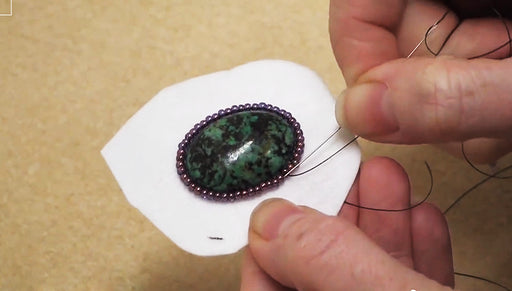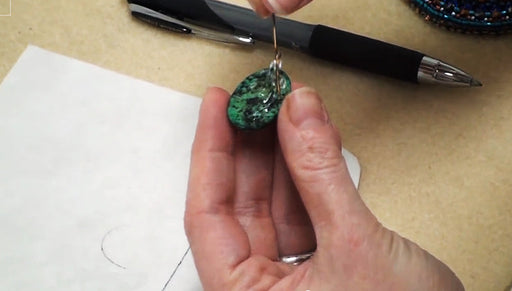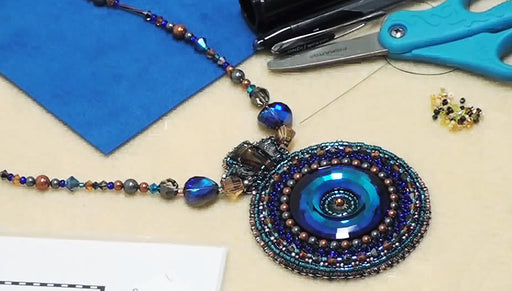
|
Beadalon Beading Mats - Prevent Bead Rolling 12 x 9 Inch (Set of 3) SKU: XTL-9930 $3.99 |

|
Lacy's Stiff Stuff Beading Foundation for Cabochons 4.25 X 5.5 Inches SKU: XCR-4210 $3.39 |

|
The Beadsmith English Beading Needles Size 12 (4 pcs) SKU: XTL-3006 $3.99 |

|
The Beadsmith Cordless Thread Zap II Thread Burner Tool SKU: XTL-0106 $16.49 |

|
Toho Round Seed Beads 15/0 49 'Opaque Jet' 8 Gram Tube SKU: JSO-0032 $2.99 |
Hi, this is Julie with Beadaholique.com and I'm going to show you how to bead embroider a bezel row around a cabochon. In this example here you can see we already have a cabochon which is glued to Lacy's Stiff Stuff. We've done a single row of bead embroidery using two bead back stitch along the exterior perimeter of the cabochon. So to do the bezel row what we're gonna do is take size 15/0 beads. You can use 14/0 as well but I want to show you a comparison for the base row where we did around the cabochon. It was a size 11/0. As you can see this quite a size difference and that's what we want because we want to continue the nice dome shape of the cabochon. The bezel row is gonna fit right here between the base row and the cabochon itself. So I went ahead and I threaded about forty inches of thread on my beading needle. So I want to show you a different way to begin your beading. Instead of tying a knot on the end of my beading needle. I'm just going to let it be loose. I'm going to take my needle and I'm gonna carefully insert it between my beads and cabochon. So right in that crevice. I'm going to pull my thread through the tail and about five or six inches. I'm going to start just the same way I began my other row I'm just gonna pick up two beads onto my beading needle and I'm gonna go ahead and conceptualize where they're going to lie. I'm going to move over about space of two beads. Bring that needle down into the crevice between my base row and my cabochon and pull through. I'm going to do the same thing I did before if watched the video on how to bead weave a back stitch. I'm gonna now go up into my bead work again in that valley between my first row and the cabochon. I'm going to pull but I'm not going to pull tight. I'm going to show what happens if I were to pull tight. You see it's distorting my base row a little bit so I don't pull tight. I want them to sit on top there and then go through the two I just embroidered. Thread knot it a little bit just work it out though it's not a true knot. Here we go. Pull that down and they're just sitting on top if you can see this from the side. They're just sitting on top of my second row in that well. So I'm going to go ahead pickup two more beads on to my needle again I'm going to visualize where they're going to fall. Place my needle in that valley pull through Now go back up and I'm going to go through three beads. Sew on two. Go back through three. Sew on two. Go back through three. Just be careful you're tension, you want them to sit on top of that other row you already strung. You don't wanna pull them down so it's not distorted. I don't want them to be hovering loosely up there either. When you get into this you'll see what I'm talking about and again two beads and then back through three. You can go all the way around your entire cabochon like this. You can see how that's starting to look. I've almost completed my entire bezel round and I want to show you how to finish it. So I've got just a little bit a gap left. I'm going to continue the same process add two beads stick that needle down into that crevice area. Go back through three. So I got just a small gap left and at this point you have to make a judgment call. Is that a one bead or two bead gap I'm going to call it a one bead gap. I'm going to add one bead. I'm going to put my needle down in between that crevice but right up against that first bead I started on. Pull my needle down through Go up through again three beads and since this is my last round I actually want to go all the way around all the beads again. I could just pull my thread through and go through the three beads or I can catch more since I'm going to have to be doing a round anyways. I'm going to go through as many beads I can Pull my thread Go through the next bead You don't wan to skip over any beads. Make sure you go through all of them. You can see what I'm doing. I'm eventually pulling this thread a little bit and that's creating a little bit more of a gap for me to get my needle in between my beads. You might find that it helps because it can be a little bit hard especially when you're working with these very tiny beads to find that entry point. I'm just pulling it down a little bit not distorting the bead work at all but just exposing hole a little bit. I'm going to check my back to see where exactly I started. Remember we have this tail to tie a knot. I'm going to show you what to do with it so just kind of judge where that is. You wanna make sure your definitely going around all the beads I've come all the way around. At this point if my beads allow I can actually do another passed through if I wanted to. That's optional. These are on here and they are secure and you sees I've got a nice even round. So I'm going to call it good but if you want you can definitely go through it again. Right where needle came out I'm going to press down through. You can tell I'm coming out very close to a starting point. Check my bead work. Make sure I'm happy with it. Now this is how you're gonna tie it off and I just your thread so you don't have quite as much. Get rid of that needle. You're just gonna make a knot. First off just going to make just a simple overhand knot. Just was under over pull that down Now I'm going to do a surgeons knot I'm going to take one go over it under and again under so I got double almost pull that tight. If you want to you can do another knot but you don't have to that it's going to hold it I'm going to take my thread zap pull my end so I can see them Make sure my knot is tight which it is zap off my threads. That is how you make a bezel row in bead embroidery. Go to Beadaholique.com for all of your beading supply needs!
Related Videos


How to Backstitch in Bead Embroidery
In this video, learn one of the most common and widely used stitches in bead embroidery - the backstitch. In this video we cover 2-bead backstitch ...
View full details

How to Glue a Cabochon onto Lacy's Stiff Stuff for Bead Embroidery
In this video learn how to glue a cabochon onto Lacy's Stiff Stuff Beading Foundation using E6000 glue. Tips are provided on how to place it to ach...
View full details

Introduction to Lacy's Stiff Stuff for Bead Embroidery
In this video learn exactly what Lacy's Stiff Stuff Beading Foundation is and how to use it. You can cut, dye, draw on it and more. A must have for...
View full detailsCustomer Reviews
You recently viewed
Clear recently viewedWas intrigued by this technique but found it very hard to see what was happening. Would like to see this tutorial done again with light beads on the dark cabochon.
This is a great instructional video especially for beginners like me. I enjoy watching Julie's videos as she is thorough and provides lots of tips. Only suggestion would be to not use black beads on this dark cabochon. They were hard to see and follow the stitching.
